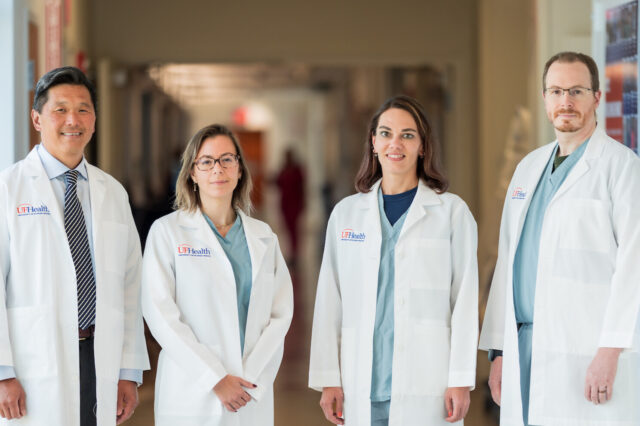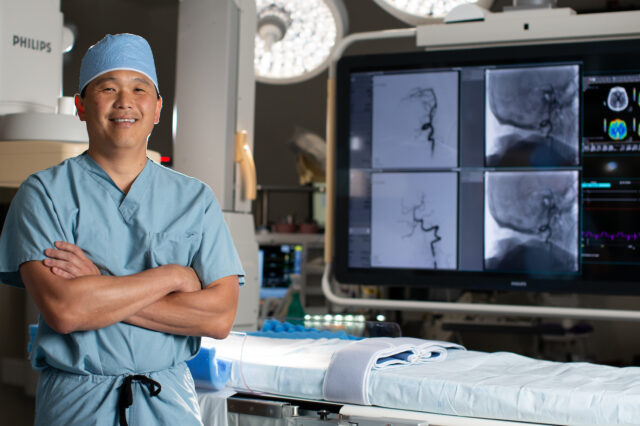The UF Health Neurovascular Program is one of the leading programs in the nation for cerebrovascular and endovascular neurosurgery. The program’s experienced UF physicians provide specialized, state-of the-art care to patients with neurovascular conditions; care that is both timely and compassionate.
The UF Health Neurovascular Program performs more than 1,000 procedures per year, including both endovascular and open cerebrovascular surgery to treat the most complex neurovascular disorders. They are pioneers in advancing the treatment of neurovascular disease through clinical and basic science research, and through developing, testing and refining the latest technologies and devices to improve patient care. These physicians are dedicated to training and educating the next generation of neurovascular surgeons.
About Brain Aneurysm
A brain aneurysm is a weakness in the wall of an artery in the brain which leads to a balloon-like sac outpouching. Cerebral aneurysms occur more commonly in women than men, and occur mainly in adults, and are rare in children.
Symptoms
A small, unchanging aneurysm may produce no symptoms. However, aneurysms are at risk for rupturing and causing bleeding in the brain. When an aneurysm ruptures, the patient may experience a sudden and usually severe headache ("worst headache of my life"), nausea, vision impairment, vomiting, and loss of consciousness. Onset is usually sudden and without warning. When an aneurysm ruptures, 50% of people die from it, and of those that live, most are permanently disabled.
Diagnosis
Diagnosis of a cerebral aneurysm is usually by CT angiogram, MR angiogram, and sometimes a catheter cerebral angiogram. If an aneurysm is suspected of rupturing, a head CT scan can diagnose the blood. A lumbar pucture may be necessary to confirm the suspicion of blood from an aneurysm rupture.
Treatment of Ruptured Aneurysm
When an aneurysm ruptures, the patient is admitted to an intensive care unit (ICU). Hydrocephalus (excess brain fluid) develops in some patients because of blood clogging the absorption channels for normal brain fluid, and placement of a ventriculostomy catheter (a plastic tubing inserted into the brain) is a life-saving treatment to drain the excess brain fluid. The cerebral aneurysm is treated to prevent it from bleeding again. A second bleed from an aneurysm that has already ruptured is associated with a 79% death rate. Cerebral aneurysms can be treated with surgery which involves craniotomy (opening the skull) and placing a titanium clip to pinch the aneurysm. Some cerebral aneurysms can be treated with coiling, a minimally invasive treatment in which tiny platinum coils are placed within the aneurysm to block it off. The coils are inserted through a tiny plastic tube that is inserted in the patient's groin and navigated to the brain using x-ray guidance and requiring no surgery.
Vasospasm
One out of three patients with a ruptured cerebral aneurysm develops a life-threatening condition called vasospasm. The brain blood vessels shrink down due to irritation and can cause strokes and death. Vasospasm is treated by raising the patient's blood pressure with medications. Sometimes patients are treated with balloons to open up the shrunken blood vessels and medications injected directly into the affected blood vessels via a tiny plastic tube inserted in the patient's groin and navigated to the brain using x-ray guidance. Often vasospasm is so severe that it does not respond to any treatment.
Treatment of Unruptured Aneurysm
Some patients have a cerebral aneurysm that is found before it ruptures. Often, these patients are advised to have their aneurysm treated to prevent it from rupturing. The aneurysm is treated either with the surgery clipping operation or the nonsurgical coiling procedure described above.
Prognosis
Fifty percent of patients with a cerebral aneurysm rupture die. The remaining surviving patients are often permanently disabled. A group of fortunate patients can survive from an aneurysm rupture and return to normal life after long recovery and rehabilitation. You may view or download our patient brochure:
Publications
Dr. Hoh has published many important medical articles regarding aneurysms.


